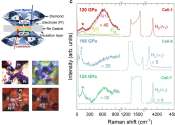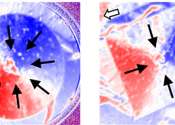Last update:
Superconductivity news

Hydride research pushes frontiers of practical, accessible superconductivity
Science is taking a step forward in the quest for superconductors that will not require ultra-high pressure to function, thanks to multinational research led by Xiaojia Chen at the University of Houston.
Condensed Matter
Apr 29, 2024
0
1

Enhanced superconductivity in monolayer FeSe films on SrTiO₃(001) via metallic δ-doping
Interface engineering has been proven to be effective in discovering new quantum states, such as topological states, superconductivity, charge density waves, magnetism, etc., which require atomic-scale heterostructure fabrication. ...
Condensed Matter
Apr 26, 2024
0
7

Scientists tune the entanglement structure in an array of qubits
Entanglement is a form of correlation between quantum objects, such as particles at the atomic scale. The laws of classical physics cannot explain this uniquely quantum phenomenon, yet it is one of the properties that explain ...
Superconductivity
Apr 24, 2024
0
26

Scientists develop novel one-dimensional superconductor
In a significant development in the field of superconductivity, researchers at The University of Manchester have successfully achieved robust superconductivity in high magnetic fields using a newly created one-dimensional ...
Superconductivity
Apr 24, 2024
0
18

Spintronics: A new path to room temperature swirling spin textures
In some materials, spins form complex magnetic structures within the nanometer and micrometer scale in which the magnetization direction twists and curls along specific directions. Examples of such structures are magnetic ...
Condensed Matter
Apr 17, 2024
0
32

The spontaneous emergence of 1D superconducting stripes at a 2D interface in an oxide heterostructure
Unconventional superconducting states are states of superconductivity rooted in physical processes that do not conform with the conventional theory of superconductivity, namely Bardeen, Cooper and Schrieffer (BCS) theory. ...

Researchers create stable superconductor enhanced by magnetism
An international team including researchers from the University of Würzburg has succeeded in creating a special state of superconductivity. This discovery could advance the development of quantum computers. The results are ...
Superconductivity
Apr 4, 2024
0
69

Putting a new spin on 1T phase tantalum disulfide: Scientists uncover a hidden electronic state
Research often unfolds as a multistage process. The solution to one question can spark several more, inspiring scientists to reach further and look at the larger problem from several different perspectives. Such projects ...
Superconductivity
Mar 22, 2024
0
5

Discovery of a hidden quantum critical point in two-dimensional superconductors
Weak fluctuations in superconductivity, a precursor phenomenon to superconductivity, have been successfully detected by a research group at the Tokyo Institute of Technology (Tokyo Tech). This breakthrough was achieved by ...
Superconductivity
Mar 22, 2024
0
325

Researchers discover new yttrium-hydrogen compounds with implications for high-pressure superconductivity
Researchers at the University of Bayreuth have made a significant scientific breakthrough by identifying new yttrium-hydrogen compounds, a discovery that has serious implications for research on high-pressure superconductivity. ...
Condensed Matter
Mar 14, 2024
0
31

Scientists reveal the first unconventional superconductor that can be found in mineral form in nature
Scientists from Ames National Laboratory have identified the first unconventional superconductor with a chemical composition also found in nature. Miassite is one of only four minerals found in nature that act as a superconductor ...
Superconductivity
Mar 13, 2024
1
270

Giving particle detectors a boost: New device acts like a superconductivity switch
In particle colliders that reveal the hidden secrets of the tiniest constituents of our universe, minute particles leave behind extremely faint electrical traces when they are generated in enormous collisions. Some detectors ...
Superconductivity
Mar 11, 2024
0
127

Preventing magnet meltdowns before they can start
The particle accelerators that enable high-energy physics and serve many fields of science, such as materials, medical, and fusion research, are driven by superconducting magnets that are, to put it simply, quite finicky.
General Physics
Mar 11, 2024
0
109

Quantum-mechanical 'molecules' spotted in superconducting devices
Electronic states that resemble molecules and are promising for use in future quantum computers have been created in superconducting circuits by physicists at RIKEN.
Superconductivity
Mar 11, 2024
0
1212

Tests show high-temperature superconducting magnets are ready for fusion
In the predawn hours of Sept. 5, 2021, engineers achieved a major milestone in the labs of MIT's Plasma Science and Fusion Center (PSFC), when a new type of magnet, made from high-temperature superconducting material, achieved ...
Superconductivity
Mar 4, 2024
6
363

Conduction-cooled accelerating cavity proves feasible for commercial applications
From televisions to X-ray machines, many modern technologies are enabled by electrons that have been juiced up by a particle accelerator. Now, the U.S. Department of Energy's Thomas Jefferson National Accelerator Facility ...
General Physics
Feb 29, 2024
1
115

Researchers develop 'foundational tool' for understanding behavior of hydride superconductors at high pressure
Hydrogen (like many of us) acts weird under pressure. Theory predicts that when crushed by the weight of more than a million times our atmosphere, this light, abundant, normally gaseous element first becomes a metal, and ...
Superconductivity
Feb 28, 2024
0
18

Fundamental equation for superconducting quantum bits revised
Physicists from Forschungszentrum Jülich and the Karlsruhe Institute of Technology have uncovered that Josephson tunnel junctions—the fundamental building blocks of superconducting quantum computers—are more complex ...
Superconductivity
Feb 14, 2024
0
65

Flowermon: A superconducting qubit based on twisted cuprate van der Waals heterostructures
Quantum technology could outperform conventional computers on some advanced optimization and computational tasks. In recent years, physicists have been working to identify new strategies to create quantum systems and promising ...

Physicists capture first sounds of heat 'sloshing' in a superfluid, revealing how heat can move like a wave
In most materials, heat prefers to scatter. If left alone, a hotspot will gradually fade as it warms its surroundings. But in rare states of matter, heat can behave as a wave, moving back and forth somewhat like a sound wave ...
General Physics
Feb 8, 2024
0
2897
More news

Quantum simulation with ultracold fermions unveils pairing pseudogap

'Flawed' material resolves superconductor conundrum

Milestone reached for superconducting undulator for European XFEL

Simulation observes three distinct phases of superconducting dynamics

Thin film reveals origins of pre-superconducting phase

Field-induced superconductivity in quantum materials
Other news

Lego-pushing bumblebees reveal insect collaboration dynamics

How E. coli get the power to cause urinary tract infections

Chemist explores the real-world science of Star Wars

Novel triple drug combination effective against antibiotic-resistant bacteria

Superconducting nanowires detect single protein ions

Myth of room temperature superconductivity in LK-99 is shattered

Research achieves photo-induced superconductivity on a chip

Room-temperature superconductor study retracted by Nature

Controlling waves in magnets with superconductors for the first time

How mantle movements shape Earth's surface

New discovery of a mechanism that controls cell division




















































